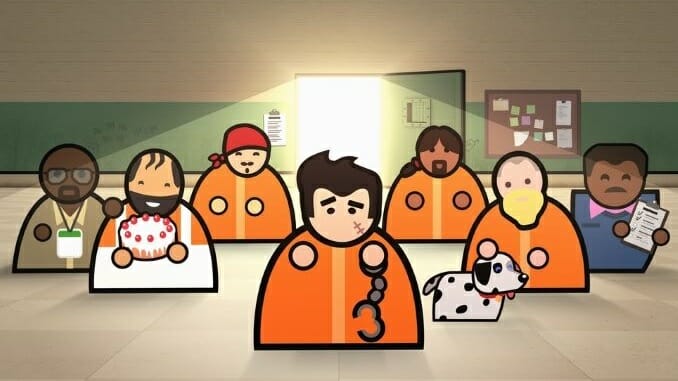Prison Architect: Second Chances Adds Rehabilitation but Still Incentivizes Punishment
Games Features Prison Architect
The first thing that Prison Architect has you do is execute a prisoner. The game walks you through building a holding cell, an execution chamber, and finally an electric chair. After upgrading the prison’s electrical grid to accommodate the new load, your guards escort the marked prisoner to his final post. “It’s not our place to decide if he deserves this,” the CEO of the prison company tells the player, “We’re just here to do a job.”
This first mission highlights what the central theme of Prison Architect has been up to this point: punishment. With the new Second Chances DLC, Double Eleven gives players new options that seem to allow a shift towards rehabilitation instead. But Second Chances never really incentivizes the player to actually make use of its rehabilitation systems over existing punishment options. With the core game revolving around maximizing your prison’s profits at the expense of your prisoner’s wellbeing, this doesn’t seem likely. Rather, Second Chances seems like an attempt by Double Eleven to sprinkle some reform options into the game, without acknowledging how the existing design stymies their use.
This is especially apparent when you consider the setting of the game. You’re not just tasked with building and maintaining a prison, but a private prison. Like any private company, your private prison company has only one real goal: turning a profit. There’s never any real urgency in the game to motivate the player outside of the constant accrual of money. Occasionally a prisoner will overdose, a riot will occur, or the rare prison break attempt will transpire. But the penalty for allowing these instances to happen are all monetary ones. The game quickly becomes a budgeting simulator after establishing your prison.
Having your prisoners in a rehabilitation program means allocating your limited amount of buildings, time, and money towards the effort. Meanwhile these resources could instead be used to coerce your prisoners into labor in furniture workshops or agricultural fields, both of which provide your prison with some meaty profits. With what the developers have chosen to prioritize in the game, the rehabilitation programs in Second Chances simply aren’t viable for Prison Architect.
Whether intentional or not, there’s a critique of the prison industrial complex buried within this unviability. Violent crimes in the U.S. dropped 49% between 1993 and 2019, according to the Pew Research Center. Despite this drastic decrease, the prison population expanded from 909,000 in 1993 to 1,464,400 in 2019. These two numbers may seem correlated on the surface, suggesting that the higher incarceration rate has led to fewer violent crimes. But studies like the Prison Paradox have shown that mass incarceration has a “marginal-to-zero” impact on crime.” Increasing the prison population hasn’t decreased crime, but it has lined the pockets of private corporations.
GEO Group, one of the largest private prison operators in the country, raked in $2.48 billion of revenue in 2019. While private prisons only make up a fraction of the prisons in the country, the use of prisoner labor is not unique to them. Every penal system in the U.S. uses prisoner labor to some degree, whether it be in the prison’s laundry room or in a workshop. These jobs pay far below minimum wage, allowing private companies and states to rake in massive profits.
In contrast, rehabilitation programs that focus on rehabilitation actually cost prisons money. The Washington State Institute for Public Policy found that an adult basic education program costs $1972 per inmate but saves the state $9176 overall, as the inmate is less likely to be re-arrested upon release. But these savings are never actually passed down to the prison, which loses out on the basically-free labor of the inmate that has been rehabilitated.
It’s this conundrum that makes the rehabilitation programs in Second Chances a bad investment. For every prisoner released through one of these programs, your prison earns a measly $1000. If a released prisoner reoffends, you’re charged a $5000 fee. The risk to reward ratio is way off, but not unfounded. As the omnipotent guide of a single prison, it only makes sense to put your financial interests before the good of an imaginary world outside the everpresent fog of war.
While Second Chances does show how prisons may be more inclined to exploit their prisoners than rehabilitate them, it never challenges this notion or explains the reasoning behind it. Instead, the player is dropped into a world where they’re told not to question orders but simply carry them out. Players can easily walk away from Second Chances with the idea that rehabilitation isn’t a viable route for criminals, with that being the only exposure they’ll ever get to the idea. In terms of simulating the penal system, Prison Architect has received a great addition with Second Chances. But as a way for players to understand why the system works as it does, the DLC falls flat.
Nicolas Perez is a freelance writer and opinion co-editor for New University. He’s rambling on Twitter @Nic_Perez_._